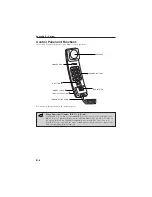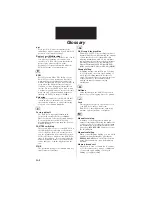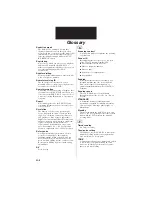
Memory sending
Scans a document into memory before the
FAX-L250 dials the numbers and sends it. This
method allows you to retrieve your original
document immediately after scanning.
`
N
Noise
A term applied to a variety of problems that
impair the operation of telephone lines used for
faxing.
Noise level
See dB (A).
Numeric buttons
The round, numbered buttons on the operation
panel marked the same as a standard telephone
keypad. Press them to perform regular dialling.
You also use the numeric buttons to enter
numbers and letters when you register numbers
and names, and for entering coded speed
dialling codes.
`
O
One-touch speed dialling
An automatic dialling method that allows you
to dial a fax or telephone number by pressing a
single one-touch speed dialling button. The
FAX-L250 can store up to 16 numbers for
one-touch speed dialling.
One-touch speed dialling buttons
The buttons numbered 1 to 16 on the
operation panel, each of which may be
registered as a fax or telephone number. Once
a number is registered, you press one button to
dial the entire number.
`
P
Paper feed
Refers to guiding a sheet of paper into the
unit’s paper path.
Pause
A timing entry required for registering certain
long distance numbers and for dialling out
through some telephone systems or
switchboards. Pressing the REDIAL/PAUSE
button enters a pause between digits of a
telephone number.
Photo
The document setting you use for sending or
copying documents with intermediate tones,
such as photographs.
Polling
One fax machine requesting another to send a
document. The receiving party calls the fax
machine holding the document to be sent, and
requests that it be sent.
Pulse
See Rotary pulse.
`
Q
Quick-on-line sending
Quick-on-line sending is the easiest and
quickest way to send a document. After a
document is set in the Automatic Document
Feeder (ADF), the FAX-L250 begins to scan
the entire document into the memory. As the
first page of a multi-page document is being
scanned, your FAX-L250 will begin to call the
other party, and transmit the information even
as the remaining pages are being scanned. The
FAX-L250 scans the document quickly so you
can get it back in a few moments and return to
work.
`
R
RECEIVE MODE
The button that controls how the FAX-L250
receives fax and telephone calls.
Receiving
Receiving transmission is also defined as RX
or Reception. The FAX-L250 can be
customised to receive fax documents in many
ways:
¶
Receive fax documents only (FAX ONLY
MODE
)
¶
Receive both telephone calls and fax
documents on the same line (Fax/Tel Mode)
¶
Receive telephone calls and fax documents
manually (MANUAL MODE)
Reception
See Receiving.
Redialling-automatic
When the fax you dial does not answer or a
sending error occurs, the FAX-L250 waits for
a specified interval and then redials the same
fax number. You can adjust the number of
redials and the length of time between
redialling.
Redialling-manual
When you use the regular dialling method, you
can quickly call the last number dialled by
pressing the REDIAL/PAUSE button.
Glossary
G-3
Summary of Contents for L250
Page 1: ...FAX L250 User s Guide...
Page 14: ...This page is intentionally blank...
Page 26: ...This page is intentionally blank...
Page 102: ...This page is intentionally blank...
Page 146: ...This page is intentionally blank...
Page 166: ...This page is intentionally blank...
Page 180: ...This page is intentionally blank...
Page 181: ...8 Making Copies This chapter describes how to make copies with your FAX L250 Making Copies 8 2...
Page 196: ...This page is intentionally blank...
Page 240: ...This page is intentionally blank...
Page 256: ...This page is intentionally blank...
Page 282: ......








































